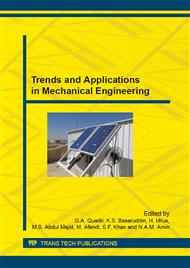p.383
p.388
p.393
p.398
p.404
p.409
p.415
p.421
p.426
The Effect of Mesh Size And Frictional Force on Simulation of Aluminium Honeycomb Under Quasi-Static Loading
Abstract:
This paper focuses on the works to model the aluminium honeycomb with the effect of meshing size that implemented into a shell body of the honeycomb and frictional force that introduced into an interaction between the honeycomb and rigid plates. The model is performed by using ABAQUS 6.12 in the explicit environment. The honeycomb with 0.0127 m cell size is modelled and three types of mesh size which are 3 mm, 1 mm and 0.8 mm are analysed based on buckling mode and load-displacement characteristics. No friction coefficient is applied during simulation. From this simulation, 1 mm meshing size is the optimize value where the load-compression pattern graph is almost similar like the experimental result compared with others meshing size. But the buckling mode is slightly different compared with the experimental result where the bottom part of honeycomb made the contract or negative expand behaviour. In order to avoid this behaviour, the friction coefficient is introduced between the honeycomb surface and rigid plates surface. Two values of friction coefficient are tested which are 0.1 and 0.3. The findings is the frictional coefficient 0.3 and meshing size 1 mm are optimized values that can avoid the contract behaviour and the result of buckling mode is similar with the experimental result.
Info:
Periodical:
Pages:
426-430
Citation:
Online since:
August 2015
Authors:
Keywords:
Price:
Сopyright:
© 2015 Trans Tech Publications Ltd. All Rights Reserved
Share:
Citation:


